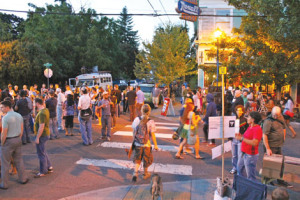Alberta Bar/Neighbor Meeting
Nov 17th – Kennedy School Community room
IN ATTENDANCE
City staff
– Theresa Marchetti – Oni Liquor Licensing
– Stephanie Reynolds – Crime Prevention
– Yolanda Sanchez – ONI Intern
Neighbors/Organizations
– Scott Canary – Neighbor off 18th
– Dean Kessler – Neighbor off 21st
– Belinda Clark – NA – Concordia –
– Sara Wittenberg – Alberta Main Street
Licensees
– James Pierce – Branch a Whiskey Bar
– Jessica Vogelin – The Know
– Tracy Ofson – Random Order Coffee House
-Clyde Wooden – Bye and Bye
-Bianca and Justin Giawngers – Binks
– Kevin Atchley – Pine Street Biscuits
– Becky Macy – Cruzroom
– Kate Verrill – Bar Lolo
– Eric Manfre – Alleyway Café
– Kay Newell – Boise NA
– Bill Leissner – SALT NECN
NOTES
Meeting is to discuss the possibility of a global Good neighbor agreement between the licensed establishments, Neighborhood Associations, and residential neighbors in close proximity to Alberta Street. This meeting does not address the concerns related to Last Thursday, but only the late night impact of businesses that serve alcohol.
Two meetings were held in March and June with only licensed establishment to begin to develop strategies to address adverse impacts from alcohol service and businesses that serve alcohol. Licensed establishments asked to be able to continue the conversation without City Staff, however, subsequent meetings never occurred.
As complaints have continued about the saturation of alcohol service on Alberta Street, the city has begun to look at strategies to address the issues aggregately. One of those options is an Alcohol Impact Area, which would impose uniform restrictions on all licensed establishments on Alberta. Street. Those restrictions could include hours of operation, types of entertainment, outdoor seating, types of alcohol served, etc. The Alcohol Impact area rule is an available avenue to local governments when problems related to alcohol service in an area cannot be attributed to one particular licensed establishment, but are more indicative of a cumulatively harmful effect. This is a strategy that is used as a last resort. The goal is to avoid this through developing an effective agreement that communicates expectations and provides for easy communication between parties.
A draft GNA was prepared incorporating some of the strategies developed in the two meetings, as well as feedback received from neighbors and the Upper Hawthorne agreement. The group went through the Draft agreement.
Concerns raised/Discussion Points:
– Bad actors are not addressed in this process. Several neighbors and licensees indicated they were disheartened to see some of the problem locations not represented at the meeting. . Several licensees stated they would not sign any agreement because they felt that it was a punishment, and one that should be only for bad actors.
There is a large spectrum between “Good Neighbors” and “Bad actors”. Many negative impacts to the community are felt because of the sheer volume of alcohol service, not because one location is the causal factor.
The process is voluntary and good faith, which means attendance and participation, cannot be compelled. However, these types of agreements have been shown to diminish livability impacts and highlight the problem locations where they have previously been allowed to hide.
GNA’s are typically not appropriate or effective where laws are being blatantly disregarded. We have other tools of enforcement for these situations.
– City of Portland asking Businesses to Police other businesses – To some extent, this is true. Community policing relies on the community to set expectations and standards for members and to apply peer pressure and oversight in situations where those norms are not upheld. In participating in this agreement, you are policing by example.
– Law states that Trash cans cannot be anywhere on Alberta Street. This needs further investigation by City staff and collaboration with the county regarding smoking laws. Sara Wittenberg from Alberta main street can provide more information as well; as more trashcans are anticipated from the Alberta Main Street organization. Tri-Met bus stops are also trash magnets.
– Agreement is too forceful, and too negative against bars. – Agreement is a draft, and can look very different if the parties all agree. It should avoid being overly vague and therefore ineffective, however. Some neighbors/licensees asked for the agreement to be strictly contact information and an agreement to talk and be responsive to one another.
– Alcohol Impact area was used as a fear tool to compel participation – City of Portland wants to be transparent with the strategies that are available and being considered for the problems on Alberta. It would be inappropriate for businesses to be facing area wide enforceable regulations with no warning.
– GNA area is too large – twenty blocks is too much. No one on 15th cares about what’s happening on 33rd. There was discussion about tri-ficating the agreement discussions (neighbors and licensees in close proximity discussing together) and then coming back to a larger group. Possibility also of using 3 separate GNA’s.
– Data/ Measures of success – What is the data that is being used to assess problems, and what will be deemed successful. How will a GNA be shown to be successful; less complaints, full participation, less documented incidents related to alcohol service?
Numbers were not available due to the need of all police resources for the Occupy event. They will come in a subsequent email.
Measurements of success would incorporate both statistical data as well as perceptions from the community.
– Why are only bars involved? What about other trash producing enterprises; non alcohol serving businesses?
Alcohol consumption can led to harm on an ecological level. Research shows this. The late night impacts experienced on Alberta are primarily form late night alcohol serving establishments. However, a community agreement amongst all businesses may also be an available avenue worth addressing.
Other Neighborhood and Business representation – Several people raised concerns that other businesses were not present because of the time; that it was too much of a hardship. Others wanted to be sure other Neighborhoods were included.
Each licensed business was personally invited to the meeting, and most indicated they would be in attendance. All 4 Neighborhood associations were also invited, as well as NECN. The issues may not be as concerning because the rains have returned and so things have slowed down on Alberta Street.
Next Steps
Participants agreed to come together with several members of industry and several neighbors to develop an agreement that is more palatable by January 16th.
City Staff to distribute email list.
(Representatives of the Bye and Bye and Binks did not list their email addresses and will not be represented on the distribution list.)
 Changes in store for Last Thursday next year as recently released by FOLT:
Changes in store for Last Thursday next year as recently released by FOLT:

